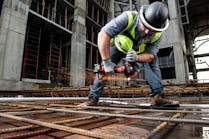This is the year government fleets fully anticipate budget crunches to affect their funding. Unanimously, fleet managers expect decreases in funding for the 2003 budget year.
State fleets' replacement rate jumped last year, and they expect to maintain it in 2003. So do locals, although at a lower percentage.
They knew it was coming. Unlike Federal budgets, most government agencies must balance each year. As income and sales-tax receipts plummeted last year, local and state government equipment fleets saw funding averages decrease or stay flat at best.
Among state fleets, 24 percent saw increased funding, but 42 percent reported decreases for a net decrease of 18 percent. On the local level—defined as city and county—the trend wasn't as marked, with the decrease coming in at 2 percent.
If that looks bad, though, consider predictions for 2003. Across the board, regardless of region or fleet replacement value, government fleets expect funding to decrease. Among states, half expect decreases and 42 percent expect funding to stay the same as in 2002. At the local level, 34 percent foresee funding declines with half expecting levels to stay the same.
But the work won't taper off, say fleet managers at both levels of government. At the state level, 26 percent, net (percent reporting an increase minus those reporting a decrease), expect work volume to increase this year; for local governments, the projected increase is 19 percent, net.
States will be far more aggressive than local governments on the fleet expansion side this year. Thirty-two percent of states expect to expand their fleets this year, with 9 percent declining. Compare this with 13 percent of local government fleet increase and 7 percent decreasing fleet size.
Machine replacement rates were solid, consistent and sustaining, and are projected to be similar this year. For state fleets, the rate of 10.5 percent projected for this year is consistent with historical averages for machine replacement at the state level. Local fleets are at a rate just off historical averages, projecting a machine replacement rate of 6.9 percent this year.
Fleet condition has suffered a bit since last year when, overall, 53 percent of managers said their fleets were in "excellent" or "very good" shape. In 2002, this percentage dropped to 46 percent. On the other end, 11 percent of government fleet managers said the condition of their machines was "fair" or "poor."
Short-term rental works well as an acquisition strategy for 54 percent of government fleets overall, with 79 percent of the state fleets renting. Thirty-five percent of states have increased the amount of rental used; 10 percent have decreased it.
Popular machines rented by government fleets include light earthmoving equipment, compaction equipment, light equipment and heavy earthmoving equipment.
Labor shortages have become less pressing for government fleets, perhaps because nearly three-quarters have kept their staffing levels flat. Nonetheless, the availability of skilled operators now plagues 37 percent of government fleet managers; 35 percent say finding skilled mechanics is a problem. In 2001, those numbers were 46 and 47 percent, respectively.
Exceptions are state fleets—where half say skilled operators are difficult to find—and the Southern and South Atlantic regions, 54 and 79 percent, respectively.










